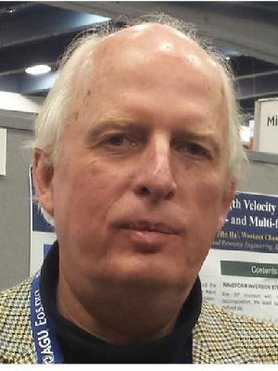

Prof.dr.ir. C.P.A. (Kees) Wapenaar
Prof.dr.ir. C.P.A. (Kees) Wapenaar
Expertise
Publications
-
2024
Application of Marchenko-based isolation to a land seismic dataset
F. Shirmohammadi / D. Draganov / J. van IJsseldijk / R. Ghose / J. Thorbecke / E. Verschuur / K. Wapenaar
-
2024
Coda-wave interferometry and time-lapse seismic reservoir monitoring
K. Wapenaar / J. van IJsseldijk
-
2024
Design, implementation and application of the Marchenko plane-wave algorithm
Jan Thorbecke / Mohammed Almobarak / Johno van IJsseldijk / Joeri Brackenhoff / Giovanni Meles / Kees Wapenaar
-
2024
Target-oriented least-squares reverse-time migration with Marchenko redatuming and double-focusing
Field data application
Aydin Shoja / Joost van der Neut / Kees Wapenaar -
2024
Waves in space-dependent and time-dependent materials
A systematic comparison
Kees Wapenaar / Johannes Aichele / Dirk-Jan van Manen -
Courses 2021
Courses 2020
Media
-
2023-02-10
Waarom het exact voorspellen van een aardbeving zo ingewikkeld is
Appeared in: Innovation Origins
-
2019-02-13
Successful kick-off meeting DeepNL
Appeared in: NWO
-
2018-12-01
EPOS-NL: Dutch research infrastructure for geo-resources
Appeared in: KNGMG Geo.brief
-
2018-11-15
NWO Fund Deep Subsurface processes
Appeared in: TU Delft News
-
2018-04-12
Dutch contribution to European Plate Observatory System awarded
Appeared in: TU Delft News
Prizes
-
2017-4-12
ERC Advanced Grant 2017
Prof. Kees Wapenaar from TU Delft received an ERC Advanced Grant worth €2.5 million for his VirtualSeis programme. For the next five years, this European grant will support the development of virtual seismology technology, for example to improve the monitoring of earthquake-sensitive areas. If it were possible to place seismometers and seismic vibrators below the ground in, for example, an earthquake-sensitive area, we could measure the source mechanism of actual earthquakes, monitor the geomechanical state of the area over time, and quantify the ground motion caused by possible future earthquakes. Moreover, we could monitor fluid flow in aquifers, geothermal reservoirs or CO2 storage reservoirs with unprecedented resolution. Unfortunately, placing seismic instruments below the ground on a large scale is not practically feasible. That is why Wapenaar is proposing to develop a methodology for creating virtual seismic sources and virtual seismometers anywhere in the subsurface, based on seismic reflection measurements carried out at the earth's surface: Virtual Seismology (VS). VS accurately mimics the responses to actual earthquakes (which would be recorded by actual buried seismometers). Wapenaar will initially develop VS to study induced earthquake problems and, in collaboration with his colleague and acquisition expert Guy Drijkoningen, apply the method in a relevant area using the latest fibre-optic technology. The collected data will be used to create virtual sources and receivers in the subsurface. This will allow them to characterise induced earthquakes, quantify the ground motion and monitor the geomechanical state of the area over time. Next, he will develop the technology for imaging and monitoring subsurface fluid flows at high resolution. According to Wapenaar, the combination of virtual seismology and the latest acquisition technology will have a major impact on the field of seismic monitoring.
-
2015
Best journal paper award: Van der Neut, J., and Wapenaar, K., 2015, Point-spread functions for interferometric imaging: Geophysical Prospecting, Vol. 63, 1033-1049
-
2013
Conrad Schlumberger Award
Conrad Schlumberger Award 2013 -
2010
Virgil Kauffman Gold Medal Award, SEG 2010
Kees Wapenaar was awarded the Virgil Kauffman Gold Medal for his thorough and extensive theoretical work on interferometric methods in the field of multidimensional acoustical and elastic imaging, and on the practical implementation of his theory with the aim to retrieve subsurface reflection responses from ambient noise recordings. Whereas others in the field followed a more physically intuitive and kinematically oriented approach, Wapenaar established a rigorous foundation for the field based on Green’s theorem and the reciprocity theorem. The application of seismic interferometry with ambient noise to retrieve 3D subsurface reflections is a direct consequence of his theory. Successful field tests have been carried out by and in cooperation with Shell. His work is now well connected to the industry practice and he has been very active in transferring technical knowledge about the new subject of seismic interferometry to a broad audience.
-
2007
Green's function representations for seismic interferometry
Best paper award
Ancillary activities
-
2023-09-12 - 2025-09-11